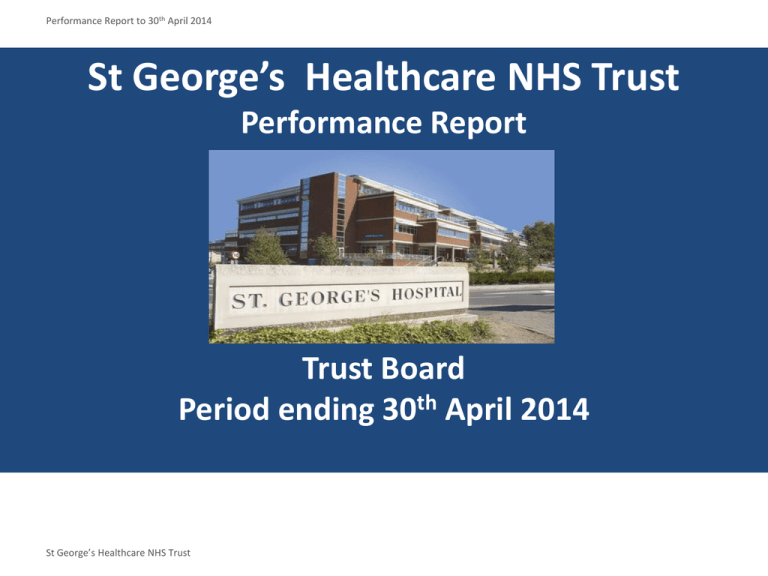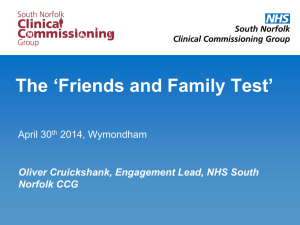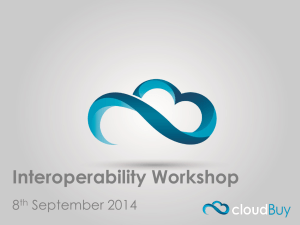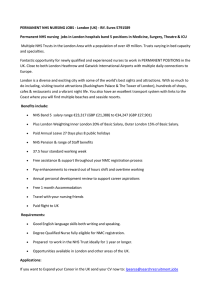
Performance Report to 30th April 2014
St George’s Healthcare NHS Trust
Performance Report
Trust Board
Period ending 30th April 2014
St George’s Healthcare NHS Trust
Contents
Section
Page
1
Executive Summary
3
2
The Performance Management Framework of the Trust
5
3
NTDA Accountability Framework
6
4
Monitor Compliance Framework
11
5
Exceptions and Actions
13
6
Definitions and Metrics
19
7
Appendices
Trends
23
Benchmarking Data
27
2
Section 1: Executive Summary
The Performance Management Framework
The Trust is realigning its Performance Framework with the requirements of the NHS Trust Development Authority (TDA) and Monitor.
The performance report is being updated to cover the new requirements of the TDA Accountability Framework for Trusts and to include
greater visibility of performance at Divisional level, alongside Trust wide aggregate performance.
The TDA Accountability Framework
The accountability framework covers three domains – Quality, Finance and Delivering Sustainability. A set of indicators has been
identified in each domain and delivery will be evaluated against a threshold and aggregated for each domain. Performance against these
indicators will determine a score for each domain. These domain scores in turn contribute towards an overall Escalation score for the
Trust. The Trusts will be rated using escalation levels 1 to 5 with Level 1 being the highest and 5 the lowest. The measurement and
monitoring process will continue to place each trust in one of five Oversight categories, based on their scoring against the various
oversight domains, relevant views of third parties such as the CQC, and the judgement of the TDA . Those categories will be:
Standard Oversight with reduced frequency–
The organisation has developed a sound FT application and received a ‘Good
or Outstanding’ rating from CIH
Standard Oversight with standard frequency:
Limited or no delivery issues
Supporting Intervention:
The organisation has some delivery issues including clinical and/or
financial challenges
Strategic Intervention:
The organisation has significant delivery issues clinical and/or financial
challenges
Special Measures:
The organisation has significant delivery issues, including serious
clinical and/or financial challenges or concerns.
The Trust is also required to sign a self certifications on a monthly basis at Board level covering compliance with Monitor’s license
requirements and a set of Board Statements .
The Monitor Compliance Framework
The Trust is reporting an AMBER/ GREEN Governance rating and a forecasted position on Continuity of Service Risks Rating of 3.
The trust is forecasting that the Governance rating be Amber / Green or Green from Q1 once ED performance and remedial plans take
full effect.
Exceptions
The reportable areas of underperformance at month 1 are as follows :
A&E <4hrs:In April performance for ED (Type 1) was 94% and ED & MIU (Type 1 & 3) was 94.7%.
3
St George’s Healthcare NHS Trust
Section 2: Performance Management Framework of the Trust
The Performance Management Framework of the Trust
The Trust continues to operate the Performance
Framework presented to the Board and Finance and
Performance Committee in April 2012. This is being
refreshed to ensure the indicators included within the TDA
Accountability Framework for NHS Trusts are reported
against and to ensure that Divisional contributions to the
Trusts aggregate reported performance are more visible.
The diagrams illustrate the components of the Trust’s
Performance Management Framework. The Trust
operates escalation processes with Divisions that reflect
the national escalation processes and the
recommendations in Monitor’s toolkits for implementing
Service Line Management.
Quarterly Performance Reviews at Divisional Level,
regular meetings with our commissioners, weekly
Executive management Team meetings to address
potential risks are all part of the Trusts Performance
Management strategy.
- Escalation actions following Divisional reviews have
focused on the action plan for recovering A&E 4 hour waits,
financial performance within SNT and MedCard Divisions
and Cancer performance to look at how delivery of the 62
day target can be improved and sustained.
.
St George’s Healthcare NHS Trust
4
Section 2: Performance Management Framework of the Trust
The Performance Management Framework of the Trust
The performance management arrangements includes quarterly reviews for each Division which review and challenge
Divisional progress, with an opportunity for Divisions to share with the Executive team issues of concern.
The Trust has extended this process by reporting divisional performance against the metrics within the TDA Accountability Framework,
to the Finance and Performance committee on a monthly basis. The Trust reports on the vast majority of these metrics within the
existing quarterly review process.
The Trust is also currently in the process of reviewing the indicators and thresholds in the scorecard in view of the most recently
published TDA Accountability framework technical guidance , updated Monitor Compliance Framework and local Trust objectives.
This work is being undertaken in conjunction with the current Performance Framework review. A draft updated performance framework
is being sent to the Executive Management Team Meeting on the 27th May after which a full suite of targets, thresholds and scoring
methodology for the trust and divisional scorecards will be agreed and routinely reported on going forward.
Divisional Reports
Divisional rag ratings will be reported in the performance reports on a quarterly basis, however actions and escalation areas will be
monitored and reported on a monthly basis and an overview provided. Any adjustments in rag rating will also be reported..
5
Section 3: The NHS Trust Development Authority
Accountability Framework for NHS Trusts
6
Section 3: TDA Accountability Framework
The Accountability Framework
The TDA will assess delivery across three domains as shown in
the diagram :
- Quality
- Finance
- Sustainability
Against each domain Trusts will report against a series of
metrics. These are listed in detail in Section 6 : definitions and
metrics
For 2014/15 trusts will be scored using escalation levels 1 to 5
with 1 being the highest risk rating and 5 the lowest. This is
being done to ensure consistency with the CQC’s approach to
assessing risk.
The measurement and monitoring process will continue to place each
NHS trust in one of five oversight categories, based on their scoring
against the various oversight domains, relevant views of third parties
such as the CQC, and the judgement of the TDA . Those categories
are:-
1. Special Measures
2. Intervention due to significant delivery issues
3. Intervention due to some delivery issues
4. Standard Oversight- limited or no delivery issues
5. Standard Oversight : Organisation has a developed
a sound FT application and received a ‘Good or
Outstanding rating from CIH.
The Trust is also required to sign off self certifications on a
monthly basis at Board level covering progress against FT
milestones, and compliance with Monitor’s license requirements
St George’s Healthcare NHS Trust
Key Elements of the Oversight Model
Moderation including
CQC Rating warning
notices and third
party report
Quality Score
(1 to 5)
Overall Escalation
score (1 to 5)
Finance RAG
Assessment
Sustainability
Score (1-5)
Caring Score
(1-5)
Effective Score
(1 to 5)report
Responsive Score
(1 to 5)
Safe Score
(1 to 5)
Well-led
(1to 5)
7
Section 3: TDA Accountability Framework : Access metrics
This section headed ‘Access’ indicates how effective the trust is at providing patients with the appointments and treatment they need and
require in accordance with the national standards and the NHS Constitution.
The ED target is that 95% or more of patients should be seen and discharged within 4 hours of attending the Emergency Department. In
April the Trust failed to meet this target with performance for ED (Type 1) at 94% and ED & MIU (Type 1 +3) at 94.7%. However for Qtr1,
the trust is on track for Type 1+3 with performance as at the 22nd May at 95.2%.
In April 1.3% of patients had their operation cancelled for non-clinical reasons against a target of 0.8% and 3.9% were not offered
another binding date within 28 days against a target of 5%. The number of operations cancelled for non clinical reasons and rebooked
within 28 days has fluctuated over the year due to bed pressures and an increase in the acuity of patients.
In April, 36.5% of LAS arrivals to patient handover times were within 15 minutes against the target of 100%. and 88.5% were within 60
minutes. St George's Hospital is not unusual in this regard as all trusts within the sector are underperforming. The trust will continue to
monitor performance closely as fines will be applied where patient handovers exceed 30 and 60 minutes.
Not yet available
St George’s Healthcare NHS Trust
8
Section 3: TDA Accountability Framework : Outcome metrics
These indicators measure the outcomes resulting from treatment activity for which the Trust is responsible. The TDA framework includes
monitoring Healthcare associated Infections and mortality.
The Trust has a target of no more than 40 Cdiff incidents in 2014/15 and the zero tolerance against MRSA continues. In April, the trust
met both the CDiff and MRSA target. There were 3 Cdiff incidents against a trajectory of 5 and no MRSA blood stream infections. The trust
will continue its programme of close monitoring and vigilance to ensure it remains complaint in 2014/15.
Prevention and education has been the focus throughout 2013/2014, with the trust aiming for zero tolerance of avoidable pressure ulcers.
In April there were 15 reported Grade 3 Pressure Ulcers and no Grade 4’s. All grade 3 and 4 pressure ulcers acquired in our care are
investigated as serious incidents, and a. full investigation and Root Cause Analysis is produced for each and reviewed at the Pressure Ulcer
Strategy group, chaired by the Deputy Chief Nurse. The PU CQUIN for 14/15 has yet to be agreed.
The trust is reporting 1 Never Event. The incident took place in March, but was not reported on Datix until April when It was promptly
declared as a SI . The incident was reported, following the retrieval of a throat swab in recovery following a dental procedure. The patient
made a full recovery and did not come to any harm.
The WHO Surgical Checklist is a surgery safety checklist used prior to all surgical procedures. Compliance is just below target at 99%.
Care group leads will continue to raise the profile through meetings and working with non compliant areas.
St George’s Healthcare NHS Trust
9
Section 3: TDA Accountability Framework : Quality governance
The Trust is required to respond to 85% of all complaints within 25 days and if this cannot be met, then an extension must be agreed
with the complainant. The target then becomes 100% of all of those complaints should be responded to within 25 days or the agreed time
In March 70% of all complaints were responded to within 25 working days and 87% were responded to when an agreed extensions
was included.
The trust has seen an increase in the number of complaints received with 116 complaints in March compared to 103 in February.
Complaints remains a key focus and priority for the Chief Nurse & DOO and is being monitored and focused on at divisional,
governance and clinical leads meetings.
There were 4 EMSA breaches in April. A root cause analysis has been undertaken and reported to the CCG. system.
The trust is reporting research activity from the Research leadership with the aim of increasing its research activity.
St George’s Healthcare NHS Trust
10
Section 4: The Monitor Compliance Framework
11
Section 4 : Monitor Compliance Framework
The Trust Rating as at 30th April 2014
•
The Trust Overall Rating is AMBER/GREEN for Performance and our forecasted position for 2014/15 for
end of April.
CoSRR is 3 at the
Performance
Rating
The 62 Day target was met in Qtr 4 and for the month of March. In March performance was 85.5%, and for the quarter
January to March performance was 85.2%
•
For Qtr 1 to date, the trust is currently non-compliant against the ED target. ED (Type 1) is 94% and ED & MIU (Type 1 & 3) is
94.7%. Current monthly performance for Type 1 & 3 as at the 22nd May is 95.2%
Forecasted
CoSRR
3
MONITOR COMPLIANCE
DASHBOARD FOR ASPIRANT FINANCIAL TRUST
April 2014
Indicators
Frequency
Period
Current /Recent
Performance
(R/A/G)
Threshold
Weighting
achieved
Indicators
Frequency
Outcomes
Clostridium( C )difficile- meeting the C.difficile
objective
3 incident in
April
Quarterly
Apr-Jun 14
3 cases YTD
40
Maximum time of 18 weeks from point of referral to
treatment in aggregate- admitted
0
Apr-Jun 14
Maximum time of 18 weeks from point of referral to
treatment in aggregate- patients on an incomplete
pathway
50%
2
0
Referral Information
Quarterly
Apr-Jun 14
Apr-Jun 14
Apr-Jun 14
50%
Quarterly
Jan – Mar 14
Cancer first definitive treatment within 31 Day
Drug
Apr-Jun 14
50%
1
0
Standard
Quarterly
Jan – Mar 14
Cancer first definitive treatment within 62 Day
Does the trust have a mechanism in place to identify and flag patients with learning disabilities and protocols
that ensure that pathways of care are reasonably adjusted to meet the health needs of these patients?
Yes
Screening
1
Does the trust provide readily available and comprehensible information to patients with learning disabilities
about the following criteria: · treatment options; · complaints procedures; and · appointments?
Cancer two week wait from referral to date first seen (2
ww)
Yes
Does the trust have protocols in place to provide suitable support for family carers who support patients with
learning disabilities
Yes
Does the trust have protocols in place to routinely include training on providing healthcare to patients with
learning disabilities for all staff?
Yes
Does the trust have protocols in place to encourage representation of people with learning disabilities and
their family carers?
Yes
Does the trust have protocols in place to regularly audit its practices for patients with learning disabilities and
to demonstrate the findings in routine public reports?
Yes
2ww
Quarterly
Jan – Mar 14
Breast
1
Learning Disability
Total for Outcomes
Weighting
achieved
Threshold
0
All cancer 31 day wait from diagnosis to Treatment
1
1
0
0
Data awaited predicting
compliance
Standard
Quarterly
Jan – Mar 14
Apr-Jun 14
A&E maximum waiting time of four hours from arrival to
admission/transfer/discharge
90%
0
92%
0
Data awaited predicting
compliance
Quarterly
Surgery
Treatment activity Information
Quarterly
Current /Recent
Performance
(R/A/G)
Quarterly
1
Data Completeness CSW
Referral to Treatment Information
Quarterly
Period
Access
100% (Mar 14)
100% (Qtr to date)
YTD 99.2%
94%
100% (Mar 14)
100% (Qtr to date)
YTD 100%
98%
85.5% Mar 14 )
85.2% (Qtr4 )
YTD 83.5%
85%
90.9% (Mar14)
93.4% (Qtr 4)
YTD 94.5%
90%
99.3% (Mar 14)
98.2% (Qtr 4)
YTD 97.7%
93%
98.1% (Mar 14)
98.9% (Qtr 4)
YTD 98%
93%
0
0
0
97.6% (Mar 14)
97.1% (Qtr 4)
YTD 97.6%
96%
94.7% (Qtr to date) as at end
of April
95%
0
1
Total for Access
1
##
Trust Overall Score for all Target and Indicators
1
Green <1.0
Amber Green= ≥1 and ≤2
Amber/Red = ≥2 and ≤4
Red= ≥4
* Unvalidated
St George’s Healthcare NHS Trust
12
Section 5 : Exceptions and Actions
Exceptions and Actions
The following pages provide a summary of performance for the areas where the Trust is not meeting the required
standards and the actions being taken to address the performance issues
St George’s Healthcare NHS Trust
13
A&E performance
Section 5: Exceptions and Actions
Performance :
April – 94.7% all types within 4 hours
Actions
•The trust is continuing to be supported by the Emergency Care
Intensive Support Team (ECIST) to implement the
recommendations which developed over a number of visits over
the last 6 months focusing on improving ED patient flow and flow
through the organisation (in and out).
•Weekly recovery meetings continue to be held with the Exec
team and the cross divisional leadership teams. This has
identified further steps the Trust can be taking to improve
performance including review of the current week, plans for the
weekend, and a look to the week ahead. This will take note of any
plans in place that would directly impact on improving ED
performance and the overall flow of patients through the system.
In April 94.7% of patients were seen within 4hours, for both Type 1 and Type 3
and for Type 1 only performance was 94.0%.
ED
MIU
ED & MIU
(Type 1)
(Type 3)
(Type 1+3)
Month of April
94.0%
99.9%
94.7%
Quarter to date (Q1)
94.0%
99.9%
94.7%
Year to date
94.0%
99.9%
94.7%
Where MIU data are not yet available average daily figures have been used and 100%
performance assumed.
•The ED continues to focus on any improvements that can be
made to the emergency / urgent pathways. This includes the
implementation of the Rapid Assessment and Treatment Service
(RATS) 7 days per week to provide early senior intervention in the
patients pathway reducing the time to treatment within the ED, the
Clinical Director is now supervisory to support the ED team on the
shop floor and to help facilitate smooth flow of patients between
ED and admitting specialties. There have also been
improvements made to the triage service and the flow of patients
linked to this and a clearer focus on the shop floor leadership for
the department.
•Following discussion with the TDA and ECIST virtual CDU and
PDU patients are now counted in the breach numbers if they have
waited more than 4 hours. Work is also underway with the mental
health teams to improve response times and the patients
experience.
•The Trust has achieved the 95% target for 4 weeks in a row –
14
from week commencing 21st April to date.
Section 5: Exceptions and Actions
18 week Referral to Treatment (RTT) performance : Admitted pathway
Performance : 90.10% compliance in April
against target of 90%
Actions
At the end of April t4 specialities failed to meet the standard.
The trust is reworking and finalising the 18 week model for 14/15
• to include the final agreed SLA numbers per specialty and
and
• to allow ENT to increase its number of breaches to reduce
its backlog and over 40 week waiters.
This will be completed for month 2 reporting and so the monthly
targets will change slightly in the next report.
RTT Admitted Pathway Performance April 2014
90.11%
90.10%
Commissioner Approved plan
Achieved
Target
Cardiology is not compliant for month 1 and will continue to be noncompliant until Q3 as the recovery plan is worked through. This is
under discussion with commissioners. Any clinical risks in
Cardiology will be reviewed at the June Patient Safety Committee.
Particular focus is being paid to avoiding any 52 week waiters (after
declaring 5 in March) and a weekly listing of all patients over 40
weeks is being sent to the Divisional Chairs and DDOs to address
with their teams.
The Admitted performance only is available at the time of the report
being produced, a verbal update will be provided at the Finance &
Performance meeting on Outpatients and Incompletes
performance.
Reporting speciality
General Surgery
Urology
Trauma & Orthopaedics
Ear, Nose & Throat
Maxillofacial Surgery
Neurosurgery
Plastic Surgery
Cardiothoracic Surgery
Gastroenterology
Cardiology
Neurology
Dental
Vascular Surgery
Gynaecology
Other
Total
Within
165
111
87
139
65
55
215
76
211
115
53
64
72
226
85
Breach
18
12
8
24
1
6
18
9
8
46
0
3
12
16
10
1739
191
%
90.2
90.2
91.6
85.3
98.5
90.2
92.3
89.4
96.3
71.4
100
95.5
85.7
93.4
89.5
15
90.1
Section 5: Exceptions and Actions
18 week Referral to Treatment (RTT) performance : 52 Week Waits
Performance : 5 patients waiting over 52 weeks in
March
Actions
The trust recognises and acknowledges the recent increase in the number
of patients waiting longer than 52weeks ,most recently five at the end of
March. The reasons for the increase in long waiting patients is multifactorial and
include :
•
Technical issues affecting patient tracking lists (PTLs) following the
Cerner PAS upgrade on 22nd February 2014, and subsequently the
patient tracking process. Much effort has gone into the corrective work
following this upgrade.
•
Multiple cancellations of the same patients where they have been unfit
for surgery. A number of these have been complex patients such as
high risk anaesthetic patients requiring repeat pre-op assessments
prior to booking which adds to the patient journey
•
A number of patients requiring specialist OP review which have had
delays in booking due to capacity constraints.
•
Clinician capacity constraints
•
Significant bed pressures experienced in Q4 2014, which resulted in a
high number of elective cancellations, subsequently impacting on
patient waits and also trust performance. This had considerable
impact during February and March 2014.
RTT performance and reducing long waits is a key priority area for the
trust, and we are taking pro-active measures to address this accordingly.
Key actions include .
Working through technical issues following the Cerner upgrade; some of
which have been resolved and some are still underway. A project board is
in place which is reviewing the implementation and monitoring
progress/resolution of outstanding issues.
52 Week breaches
6
Weekly escalation email of long waiters is now sent by the Associate
Director of Finance, Contracting and Performance to the Divisional
Directors of Operations and Divisional Clinical Chairs to review personally
and action those patients waiting for more than 40 weeks.
A monthly RTT Compliance meeting chaired by an Executive Director is
held which reviews; performance by care group with a particular focus on
patients waiting 40+ weeks to ensure treatment plans are in place,
review/facilitate escalation, provide senior decision making support to drive
actions forward, reviews and monitors elective cancellations, their
rebooking to target and their impact on RTT performance.
Recruitment of additional consultants in clinical areas of capacity
constraints, such as ENT
5
Number of Waiters
Weekly Referral to Treatment management meetings by care group are
now in place which track the Patient Tracking List and review at patient
level, review capacity and escalate long waits.
4
The trust has recruited and now has in post a Director of Delivery and
Improvement who is leading on service transformation, working closely
with the divisions to ensure we implement our capacity plans and meet
performance targets as we continue to improve our services.
3
2
1
0
Monthly meetings are being held with South London CSU reviewing RTT
performance, and RCAs for long waiting patients.
Incomplete
Admitted Adjusted
Non-Admitted
16
Section 5: Exceptions and Actions
Performance : Total of 3 Cdiff cases in April vs a
monthly trajectory of 5 and a annual target of 40. A
total of zero MRSA cases year to date
Actions
C.Difficile
With the annual total number of cases below trajectory the
trust is happy that it current strategy has reaped results with its
lowest ever number of CDiff cases in three years.
5
5
5
The trust will continue to maintain its good performance as it
faces an even more challenging target of 40 incidents in
2014/15 .which should be achievable
4
4
Number
3
3
3
3
3
3
3
3
3
2
3
2
1
MRSA Bacteraemia
The root cause analysis for each bacteraemia is presented to
the HCAI taskforce,
The Trust will continue its trust wide communication and
vigilance to improve compliance
0
The Infection control and the Vascular Access teams are also
available to provide additional support. Weekly awareness
sessions on line care continues
Months
Trajectory
2014/15 Actual (cum)
The Trust has a target of no more than 40 Cdiff incidents in 2014/15. There were 3
Cdiff incidents against a trajectory of 5 and no MRSA blood stream infections. The
trust will continue its programme of close monitoring and vigilance to ensure it
remains complaint in 2014/15.
The zero tolerance against MRSA continues in 2014/15. The trust can report that in
April there were no MRSA bacteraemias
In 2014/15 the zero tolerance approach to MRSA bacteraemia
(hence no national target) remains, and the trust will maintain its
current strategy and continue to monitor this closely to avoid
being non compliant
Following an appeals process,
a 7th bacteraemia which
occurred in March, has been assigned to St George’s bringing
the total for 13/14 to 7. It was agreed that this did not cause a
clinical infection but could have been a transient bacteraemia as
the patient was on antibiotics sensitive to the bacteria. However
the guidance does not accommodate this within its definitions
and thus had to be assigned as a contaminant which is allocated
to the organisation that took the blood culture (St
George’s). The chair of the appeal panel will be writing to NHSE
to raise this issue and suggest that the guidance is changed.
17
Section 5: Exceptions and Actions
Cancer Performance- 62 Day
Performance : 62 Day waits 85.5% compliance against
target of 85%
Actions
The 62 Day target was met in March , with performance at
85.5%. Despite not having met the target for 6 months out of
the 12 months the Trust is happy to report that it also met the
target for Quarter 4 with performance at 85.2%.
The trust will continue with the following plans to ensure the
target is met and sustained:-
The 62 Day target was met in March, with performance at 85.5%.
All other cancer targets were met for the full year 2013/14.
1. Implementation of single Cancer Management Team
based at SGH, providing full visibility of the cancer
performance for the whole organisation
•The scheduling and uploading contract would be transferred
to SGH with effect from 1 July 2014 and KHT would take on
the activity provided by their consultants.
•Temporary staff have been recruited to the SGH TWR Office
to manage the additional workload. Substantive staff will be
recruited once the budget transfer takes place.
•Meetings have been held and a new urology pathway will be
implemented when new consultants come into post.
2. Development of a 62 day PTL capturing all TWR referrals
received at SGH (not including QMH) to ensure
performance against this target
• Work started in mid-February as planned and all tumour
types are now receiving a PTL although there is more
validation work required. Meetings have been set up with
clinical leads, service teams and MDT co-ordinators to proactively manage pathways and take remedial action to avoid
any breaches where possible
3. The transfer of the monitoring and reporting of QMH
activity to St George’s enabling a direct feed from QMH
PAS to the St George’s cancer informatics
•Awaiting resolution by IT before the Infoflex development
work can begin
• The development work and the commissioning of the new
system is expected to be fully operational within 9 – 1218
months.
Section 6: Definitions and Metrics
19
Section 6: Definitions and metrics
TDA Accountability Framework
The following pages provide details of the metrics included in the TDA performance framework applicable to
Acute Trusts.
Caring
Inpatient scores from Friends
and Family Test
A&E scores from Friends and
Family Test
Complaints – rate per bed days,
MH contacts or calls to
ambulance services
Inpatient Survey: Q68 Overall I
had a very poor/good
experience?
Mixed Sex Accommodation
Breaches
Well-led
Effective
Safe
NHS England inpatients response rate
from Friends and Family Test
Summary Hospital Mortality
Indicator
(HSCIC Published data)
CDiff
NHS England A&E response rate from
Friends and Family Test
Data Quality of trust returns to the
HSCIC
NHS Staff Survey: Percentage of staff
who would recommend the trust as a
place of work
NHS Staff Survey: Percentage of staff
who would recommend the trust as a
place to receive treatment
Hospital Standardised Mortality
Ratio
(DFI Quarterly)
Hospital Standardised Mortality
Ratio
– weekend
Hospital Standardised Mortality
Ratio
– weekday
Deaths in low risk conditions
Trust turnover rate
Trust level total sickness rate
Total trust vacancy rate
Temporary costs and overtime as %
total pay bill
Emergency re-admissions within
30 days
following an elective or emergency
spell at
the trust
MRSA
Never Event incidence
Medication errors causing
serious harm
Maternal deaths
Proportion of patients risk
assessed for Venous
Thromboembolism (VTE)
Serious incidents
Proportion of reported patient
safety incidents that are
harmful
Admission to adult facilities for
patients who are under 16
years of age (Number)
Percentage of staff with annual
appraisal
20
Section 6: Definitions and metrics
TDA Accountability Framework
The following pages provide details of the metrics included in the TDA performance framework applicable
to Acute Trusts
Responsive
Responsive contd
Proportion of patients spending more than 4 hours in A&E
Urgent operations cancelled for a second
time
RTT waiting times for admitted pathways: % within 18 weeks
RTT waiting times for non-admitted pathways: % within 18
weeks
RTT waiting times incomplete pathways
RTT over 52 week waiters
Diagnostic waiting times: patients waiting over 6 wks for a
diagnostic test
Proportion of patients receiving first definitive treatment for
cancer within 62 days of referral from GP
Finance
Bottom line I&E position – Forecast
compared to plan
Proportions of patients not treated within
28 days of last minute cancellation due to
non clinical reasons
Bottom line I&E position – Year to date
actual compared to plan
Certification against compliance
regarding access to health care for people
with a learning disability
Actual efficiency recurring/non
recurring compared to plan- Year to date
actual compared to plan
12 hour trolley waits in A&E
Actual efficiency recurring/nonrecurring compared to plan – Forecast
compared to plan
Proportion of patients receiving first definitive treatment for
cancer within 62 days of referral from screening
Forecast underlying surplus/deficit
compared to plan
Proportion of patients receiving first definitive treatment for
cancer within 31 days of decision to treat
Forecast year end charge to capital
resource limit
Proportion of patients receiving subsequent treatment within
31 days (Drug)
Proportion of patients receiving subsequent treatment within
31 days (Surgery)
Is the Trust forecasting permanent PDC
for liquidity purposes?
Proportion of patients receiving subsequent treatment within
31 days (Radiotherapy
Proportion of patients receiving subsequent treatment within
31 days (Radiotherapy
Proportion of patients seen within 14 days of urgent GP
referral
Proportion of patients with breast symptoms seen within 14
days of GP referral
21
Section 7: Appendices
22
Trends
Monthly Trust Performance
Monthly Trust Performance
Monthly Trust Performance
Appendix 1: Benchmark Data
27
Accident and Emergency (All type): 4 hour wait
April 2014
28
Accident and Emergency (Type 1): 4 hour wait
April 2014
29
Accident & Emergency:
Week Ending 30th March 2014
All type A&E: 94.88%, up from 94.69% last week
Type 1: 91.71%, up from 91.42% last week
For week ending: 11/5/2014
London is ranked 2nd for All Types and 3rd for Type 1 performance.
For QTD performance, London is ranked 2nd for All Types, and 4th for Type 1
(National ranking is based on the 4 commissioning regions)
30
MRSA Dashboard 2014-15
NB. Trajectories for 2014/15
Sector
NEL
NEL
NEL
NEL
NEL
NEL
NEL
NEL
NEL
NEL
NWL
NWL
NWL
NWL
NWL
NWL
NWL
SL
SL
SL
SL
SL
SL
SL
SL
Total
are Zero for MRSA.
Trust Name
Total for
last 12
months
Total for last
3 months
Barking, Havering And Redbridge Hospitals NHS Trust
Barnet And Chase Farm Hospitals NHS Trust
Barts Health Trust
Great Ormond Street Hospital For Children NHS Trust
Homerton University Hospital NHS Foundation Trust
North Middlesex University Hospital NHS Trust
Royal Free NHS Foundation Trust
Royal National Orthopaedic Hospital NHS Trust
University College London Hospitals NHS Foundation Trust
Whittington Hospital NHS Trust
NEL TOTAL
Chelsea And Westminster Hospital NHS Foundation Trust
Ealing Hospital NHS Trust
Hillingdon Hospital NHS Trust
Imperial College Healthcare NHS Trust
North West London Hospitals NHS Trust
Royal Brompton And Harefield NHS Trust
West Middlesex University NHS Trust
NWL TOTAL
Croydon Healthcare Services NHS Trust
Epsom And St Helier NHS Trust
Guy's and St Thomas's NHS Foundation Trust
King's College Hospital NHS Trust
Kingston Hospital NHS Trust
Lewisham Healthcare NHS Trust
Royal Marsden NHS Foundation Trust
St George's Healthcare NHS Trust
SL TOTAL
LONDON
2
5
12
1
5
4
0
0
5
1
35
3
1
0
10
2
1
5
22
2
8
4
7
5
1
1
5
33
90
0
0
3
0
2
0
0
0
0
0
5
1
0
0
2
0
0
1
4
2
2
1
1
2
0
0
0
8
17
1
Number of Number of cases 2014-15 YTD 2013-14 YTD position
cases last so far this month
Position to
to the end of April
month (April
(May 2014)
15th May 2014
2013
2014)
0
0
1
0
1
0
0
0
0
0
2
0
0
0
1
0
0
0
1
0
0
0
1
0
0
0
0
1
4
0
0
1
0
0
0
0
0
0
0
1
0
0
0
0
0
0
0
0
0
0
0
0
0
0
0
0
0
1
0
0
2
0
1
0
0
0
0
0
3
0
0
0
1
0
0
0
1
0
0
0
1
0
0
0
0
1
5
0
1
0
0
1
2
0
0
0
0
4
1
0
0
0
0
0
0
1
0
0
2
3
0
0
0
0
5
10
Trust above 0 threshold
Trust achieving 0 threshold
31
C.Difficile Dashboard 2014-15
Sector
Trust Name
NEL
NEL
NEL
NEL
NEL
NEL
NEL
NEL
NEL
NEL
NWL
NWL
NWL
NWL
NWL
NWL
NWL
SL
SL
SL
SL
SL
SL
SL
SL
Total
Barking, Havering And Redbridge Hospitals NHS Trust
Barnet And Chase Farm Hospitals NHS Trust
Barts Health Trust
Great Ormond Street Hospital For Children NHS Trust
Homerton University Hospital NHS Foundation Trust
North Middlesex University Hospital NHS Trust
Royal Free NHS Foundation Trust
Royal National Orthopaedic Hospital NHS Trust
University College London Hospitals NHS Foundation Trust
Whittington Hospital NHS Trust
NEL TOTAL
Chelsea And Westminster Hospital NHS Foundation Trust
Ealing Hospital NHS Trust
Hillingdon Hospital NHS Trust
Imperial College Healthcare NHS Trust
North West London Hospitals NHS Trust
Royal Brompton And Harefield NHS Trust
West Middlesex University NHS Trust
NWL TOTAL
Croydon Healthcare Services NHS Trust
Epsom And St Helier NHS Trust
Guy's and St Thomas's NHS Foundation Trust
King's College Hospital NHS Trust
Kingston Hospital NHS Trust
Lewisham Healthcare NHS Trust
Royal Marsden NHS Foundation Trust
St George's Healthcare NHS Trust
SL TOTAL
LONDON
Annual
Trajectory
Year to date
Trajectory to
15th May
Total for
last 12
months
Total for
last 3
months
Number of
cases last
month
37
20
71
7
2
17
38
13
57
19
281
8
8
16
65
18
9
19
143
17
40
37
58
24
39
16
40
271
695
4.63
2.50
8.88
0.88
0.25
2.13
4.75
1.63
7.13
2.38
35.13
1.00
1.00
2.00
8.13
2.25
1.13
2.38
17.88
2.13
5.00
4.63
7.25
3.00
4.88
2.00
5.00
33.88
86.88
23
34
75
12
4
25
27
8
89
20
317
11
12
10
47
20
15
12
127
11
41
48
66
18
40
19
23
266
710
4
11
11
1
2
12
5
0
15
5
66
2
3
0
14
2
3
4
28
3
9
13
12
1
5
5
7
55
149
2
5
6
0
1
3
2
0
4
2
25
2
2
0
7
1
0
1
13
1
2
5
6
1
1
0
3
19
57
Number of
Number of cases
2013-14 YTD
cases so far from 1st April 2014 - number of cases
this month
15th May 2014 to end April 2013
(Provisional)
0
2
1
0
5
3
0
6
5
0
0
0
1
2
0
6
9
2
0
2
5
0
0
1
2
6
10
0
2
3
9
34
30
0
2
0
0
2
2
0
0
0
0
7
12
0
1
2
0
0
1
0
1
6
0
13
23
0
1
3
2
4
2
2
7
1
0
6
5
0
1
2
0
1
4
2
2
1
2
5
9
8
27
27
17
74
80
Note – The 2014/15 weekly C.diff numbers are aggregated at provider level but not attributed to the Trusts, therefore to avoid giving an
inaccurate position we have omitted any comparison to plan and associated RAG rating.
* Data in the body of the report may not
reflect more recent updates
32







